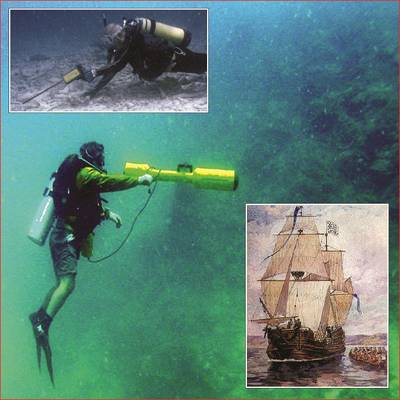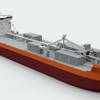Historic Great Lakes Shipwreck Possibly Discovered
Steven Libert, president of the Great Lakes Exploration Group, announced he has located what is believed to be the remains of Le Griffon, the first European ship to have sailed the upper Great Lakes.
The 45-ton barque carrying seven cannons was built by the legendary French explorer Rene-Robert Cavalier, Sieur de La Salle who was attempting to establish a Northwest Passage through Canada. La Salle wanted to provide a faster way to connect France with its trading partners in the Far East and Le Griffon was to be a vital link in the route between Niagra and Illinois. On its maiden voyage the ship sailed through unchartered waters across Lake Erie, Lake Huron, and Lake Michigan. On its return trip Le Griffon and her crew of six disappeared.
Libert has spent the last 30 years researching historical records and conducting exploratory dives in upper Lake Michigan. On one of his these dives last summer Libert and his group discovered an area with a large hand-hewn wood timber protruding from the bottom. It is thought to be the vessel’s bowsprit and carbon dating tests done on a sample by Beta Analytic Laboratories in Miami and the University of Arizona are promising, but not conclusive. To confirm the exact identity of the vessel requires locating more items from the site, but with much of the ship entombed in the lake bottom, some high tech equipment is needed. Key artifacts to find would be one or more of the seven cannons. To effectively search the football field size area, Libert has acquired JW Fishers PT-1 pinpointing magnetometer. A powerful detector of ferrous metal, the PT-1 can easily locate individual ferrous artifacts even on a wreck site littered with many iron objects. To protect the scientific and historic value of this incredible find, a partnership has been established with the state of Michigan and the Republic of France. Work is continuing as weather permits.
Another explorer utilizing the magnetometer is professor and maritime archaeologist Greg Cook at the University of West Florida in Pensacola. “The thrill of discovery is what I love about archaeology,” Cook said. “When you pick up an artifact that is more than a century old, it’s like travelling through time.” The professor works with the university’s Archaeology Institute, which is both an educational and research facility. Part of their mission is the examination of historic and prehistoric sites, both on land and underwater. In addition to a professional staff of nine archaeologists, the institute has artifact conservation labs, exhibit space, and other special equipment including remote sensors for the marine environment. One of these devices is Fishers Diver Mag 1 hand-held magnetometer which can locate a large wreck at more than a quarter mile away. Another device is Fishers Pulse 8X underwater metal detector which helps in locating the nonferrous metal artifacts.
The Philippines is made up of more than 7,000 islands. Over the centuries, explorers from around world have traded with its inhabitants, and over the years thousands of ships have crashed on its reefs, sunk in typhoons and been plundered in wars. The area is a veritable graveyard of historic wrecks which caught the attention Captain Steve Morgan, who was fascinated by the tales of those lost ships and their valuable cargoes of porcelain, jewels and riches. Morgan formed the company Black Coach Management in the 1990s and began to acquire the men and equipment needed to find these historic time capsules. Three of the pieces the group picked up were JW Fishers SeaOtter ROV, a remote operated vehicle with high resolution video camera capable of descending to depths of 500 feet, a Diver Mag 1 magnetometer, and the Pulse 8X metal detector. One of the first wrecks the Black Coach team began to hunt was a Spanish Galleon that had sailed from the province of Palawan in the late 1700s carrying three large bronze bells for the newly constructed catholic missions in California. The ship was attacked and sunk by pirates and for more than 200 years lay hidden on the bottom of the South China Sea. The remains were discovered by local divers who came upon what they described as “a reef on the bottom that is not really a reef.” That “reef” proved to be the ship’s cargo arranged in a pile 60 feet long, 10 feet high and more than 25 feet wide. Morgan and his team, working with Philippine archaeologists, used the ROV to survey the wreck lying at a depth of 170 feet. Divers were then sent down with the metal detector and magnetometer and recovered hundreds of artifacts from the site.
A few of the many other explorers and archaeologists using Fishers detectors are Dr. Bridget Buxton with Univ. of Rhode Island, Dr. Charles Beeker at Indiana Univ., Clive Cussler’s NUMA, Mel Fishers’ Salvors Inc, Cultural Resources Dept. Biscayne Ntl. Park in Florida, Odyssey Marine Exploration, North Carolina’ Dept. of Cultural Resources, Woods Hole Oceanographic Institute, Max-Planck Institute in Germany and Sea Heritage Panama.
jwfishers.com












